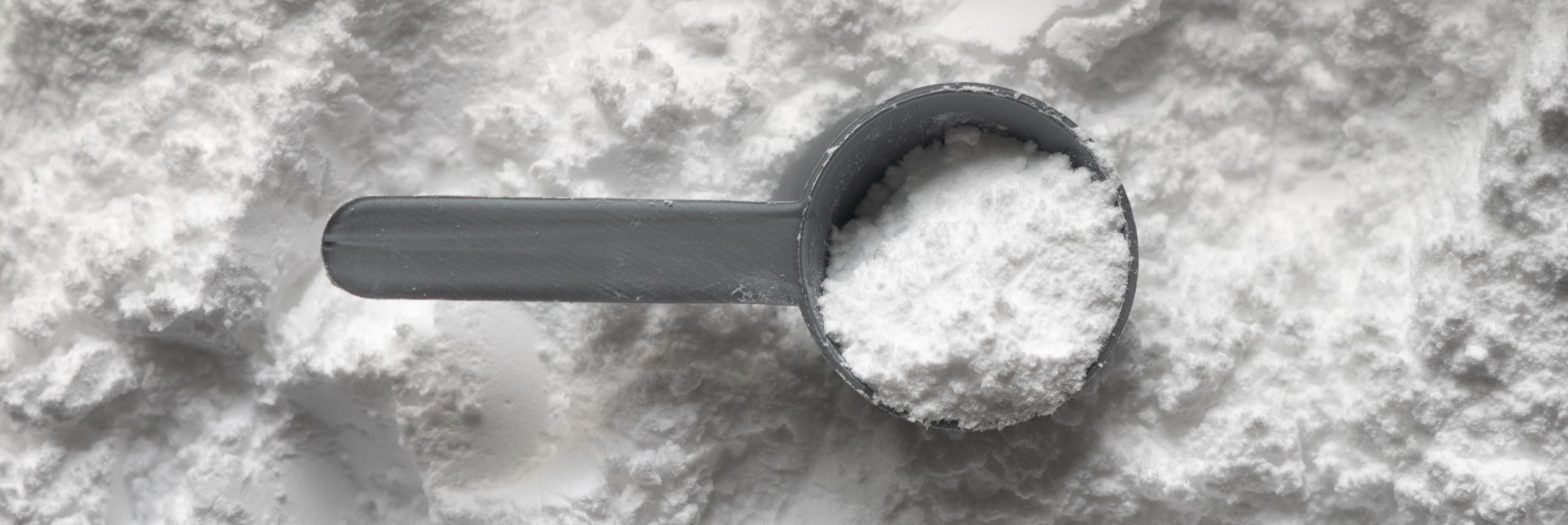Creatine is one of the most widely investigated supplements and this is for a good reason.
In this blog post you will find everything that you need to know about creatine. After reading this post you will know exactly what creatine is, how creatine works, how creatine can help in your training, which form of creatine to buy, and much more!
Highlights:
– Creatine is a natural substance in our bodies that is important for energy provision.
– Creatine is a safe supplement and well-tolerated when used appropriately.
– The best (cost-effective) form of creatine to use, is creatine monohydrate.
– For supplementing creatine, we would recommend for the first 5-7 days to take about a total of 20 g of creatine spread over 4 portions during the day, followed by about 5 grams in one portion per day afterwards.
– Creatine enhances muscle building, strength, and resistance exercise capacity.
– Creatine has limited benefits for endurance exercise but may improve sprint performance and short-term endurance efforts during intermittent sports.
– The impact of creatine on bone strength and exercise recovery is still being investigated, but so far there are no clear indications that it can help (a lot) for those aspects.
– Creatine does not seem to help during injury/immobilization, but it could help in speeding up recovery (during rehabilitation) from such events.
– Creatine may be beneficial for brain function and cognition, especially during periods of intense cognitive demands or sleep deprivation.
– Creatine may also help in mental health issues and concussion or brain injury.
– There is no evidence to support claims that creatine leads to hair loss, kidney damage, or dysfunction when taken at recommended dosages.
Table of contents
- What is creatine?
- How does creatine work?
- Creatine supplementation:
- Is creatine supplementation safe?
- What is the impact of creatine for muscle building?
- What is the impact of creatine for muscle strength?
- What is the impact of creatine for endurance exercise?
- What is the impact of creatine for intermittent sports such as football, basketball, or martial arts?
- What is the impact of creatine for bone strength?
- What is the impact of creatine for recovery from exercise?
- What is the impact of creatine during injury or recovery from injury?
- Brain
- Creatine supplementation for the brain
- The impact of creatine on cognition
- The impact of creatine on mental health
- The impact of creatine on concussion and traumatic brain injury
- Concluding remarks for creatine and the brain
- What form of creatine is the best to buy?
- What is the best creatine dosing or creatine intake strategy?
- Are there differences between males and females and between young and old for creatine supplementation?
- Are there side effects of creatine supplementation?
- Does taking creatine lower your body’s natural production, and do you need to stop taking it to return to normal levels?
- Does creatine lead to hair loss/baldness?
- Does creatine lead to kidney damage and/or renal dysfunction?
- Conclusion
1. What is creatine?
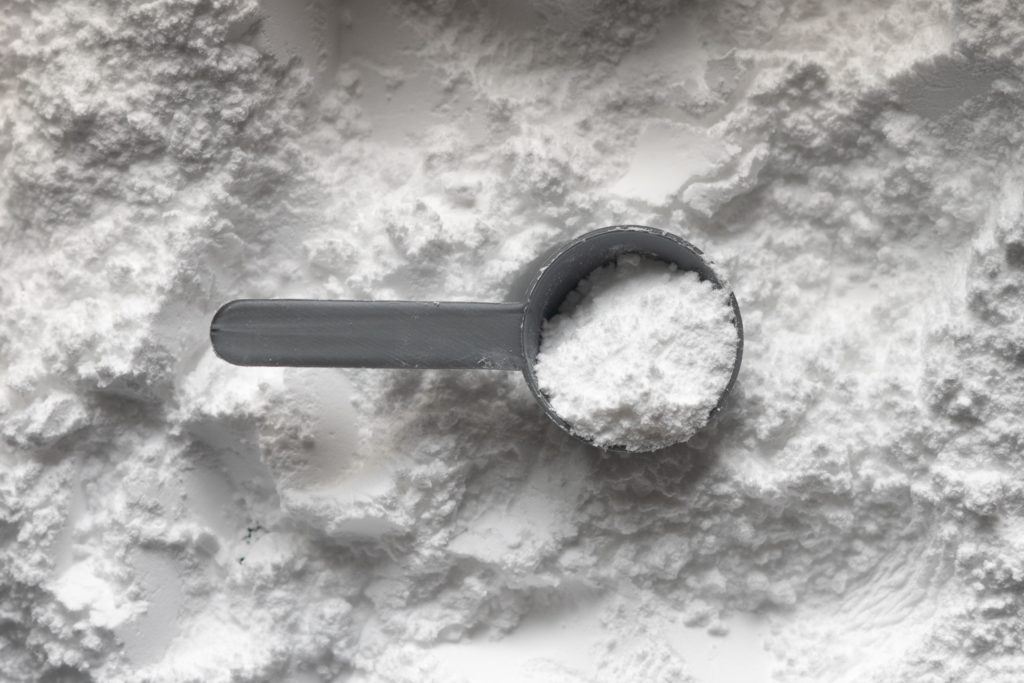
Creatine (also known as methylguanidine-acetic acid) is a natural substance found in our bodies and is involved in energy metabolism. Whereas a small amount of creatine can be found in the brain, liver, kidneys, and testes, the vast majority (~95%) is stored in our muscles in two forms (1). About 35% as free creatine and ~65% as phosphocreatine (2). Creatine plays a crucial role in providing energy for high-intensity, short-duration activities, such as weightlifting, sprinting, and jumping.
Chemically, creatine is a ‘nitrogenous organic substance’ derived from the amino acids arginine, glycine, and methionine. In other words, it is a substance that is produced from several amino acids in our body. Within our body, creatine is produced primarily in the liver, kidneys, and pancreas.
It can be produced in a two-step process. First, arginine and glycine form ornithine and guanidinoacetic acid (GAA) by the enzyme arginine glycine amidinotransferase (AGAT). Thereafter, creatine is formed by the transfer of the methyl group from S-adenosyl methionine to guanidinoacetate (Figure 1).
Creatine can also be obtained through dietary sources such as red meat, fish, and poultry (3-5). As an example, 1 pound (~450 grams) of uncooked salmon or beef contain about 2 grams of creatine (5). When you cook these products some of the creatine will be lost (and converted partly to creatinine) (6). Plant-based products contain very low amounts of creatine. Therefore, strict vegetarians and vegans have on average 15-20% lower skeletal muscle total creatine stores (7). Overall, when eating a normal omnivorous diet, people already ingest on average around 1-2 gram of creatine per day. And this is important…
… because every day about 2 g (1-2%) of creatine in our muscle cells will be broken down and excreted in our urine as creatinine (2). Therefore, the production in our own body, together with the creatine coming from our diet will replace these losses. In that way we can maintain our own creatine stores in the body.
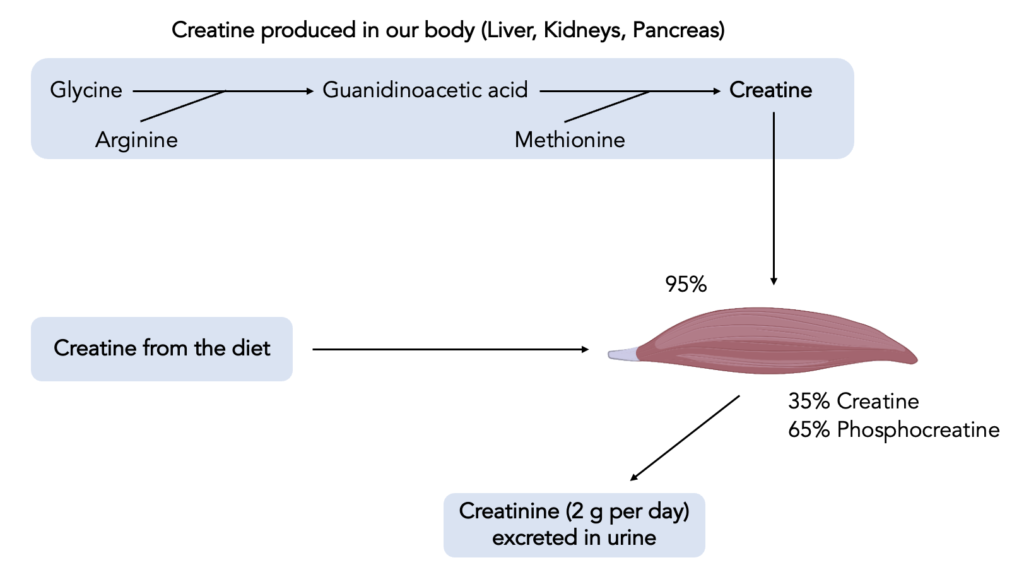
Figure 1. Illustration of how we maintain creatine in our muscles. Creatine is produced in our Liver, Kidneys, and Pancreas in a two step proces from glycine, arginine, and methionine. It can also enter our body through dietary intake. Creatine is for 95% taken up into our muscles and there it will be stored as free creatine (35%) or as phosphocreatine (65%). Approximately 2 grams of creatine will be broken down to creatinine and is excreted via our urine. Figure redrawn from (8).
2. How does creatine work?
Once creatine is produced or ingested, it is transported to different organs such as the muscles. In the muscles, creatine gets converted into phosphocreatine (also commonly abbreviated as PCr). Phosphocreatine serves as a readily available energy reservoir that can quickly donate its phosphate group to adenosine diphosphate (ADP), resulting in the formation of adenosine triphosphate (ATP); See Figure 2 for a schematic overview. ATP is the primary energy currency of our cells and is essential for various cellular processes in our entire body, including muscle contraction, neurotransmission, and protein synthesis. If phosphocreatine levels are low in the muscles, we cannot sustain continued muscle contractions during high-intensity exercise such as resistance exercise.
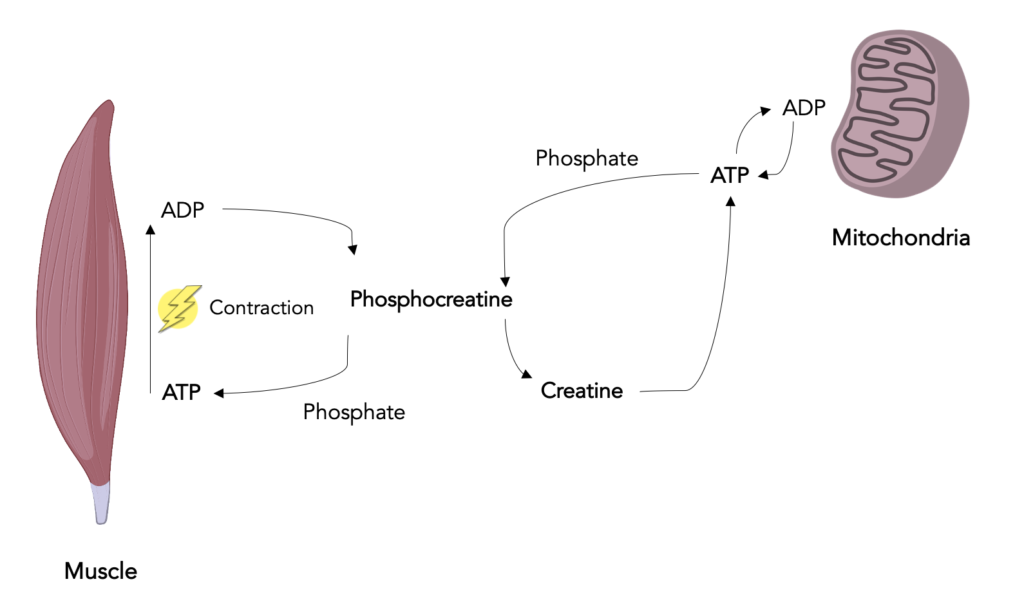
Figure 2. Illustration of how Creatine helps to provide energy to the working muscle. When muscle contracts it needs energy (in the form of ATP). After a muscle contraction this ATP will be converted into ADP. In order to be able to contract again, the muscle needs ATP again and this keeps occurring during every muscle contraction (for example when you lift weights). Phosphocreatine is able convert ADP into ATP very fast, so muscle contractions can occur quickly after each other. In order to convert ADP into ATP, the Phosphocreatine needs to give its ‘Phospho’ (Phosphate) to ADP. Therefore, Creatine will be free in the muscle cell again. This Creatine can travel towards the Mitochondria (which is also present in a muscle cell) to get another ATP and it uses that ATP to take the Phosphate group to form Phosphocreatine again. The mitochondria are the powerhouses in the muscle cells and are able to continuously produce ATP that can be used by Creatine.
During intense physical activities, the demand for ATP increases rapidly. By donating its phosphate group, phosphocreatine helps replenish ATP levels, allowing the muscles to sustain high-energy output for a short period. This ATP-PCr system provides rapid energy for quick bursts of activity, such as lifting heavy weights or performing explosive movements.
3. Creatine supplementation:

Apart from ingesting creatine via our diet, we can also take creatine supplements. Supplementing with creatine has become popular among athletes and fitness enthusiasts due to its potential benefits. Early research has clearly shown that with a proper oral creatine dosing protocol (for more information, see section 19), you can increase your creatine stores within the muscle by 20-40% (9-11). This increase of creatine in the body can have several beneficial effects given its impact on energy provision (what we just discussed).
However, before we dive into these effects, let’s first see whether creatine supplementation is actually safe to consume.
4. Is creatine supplementation safe?
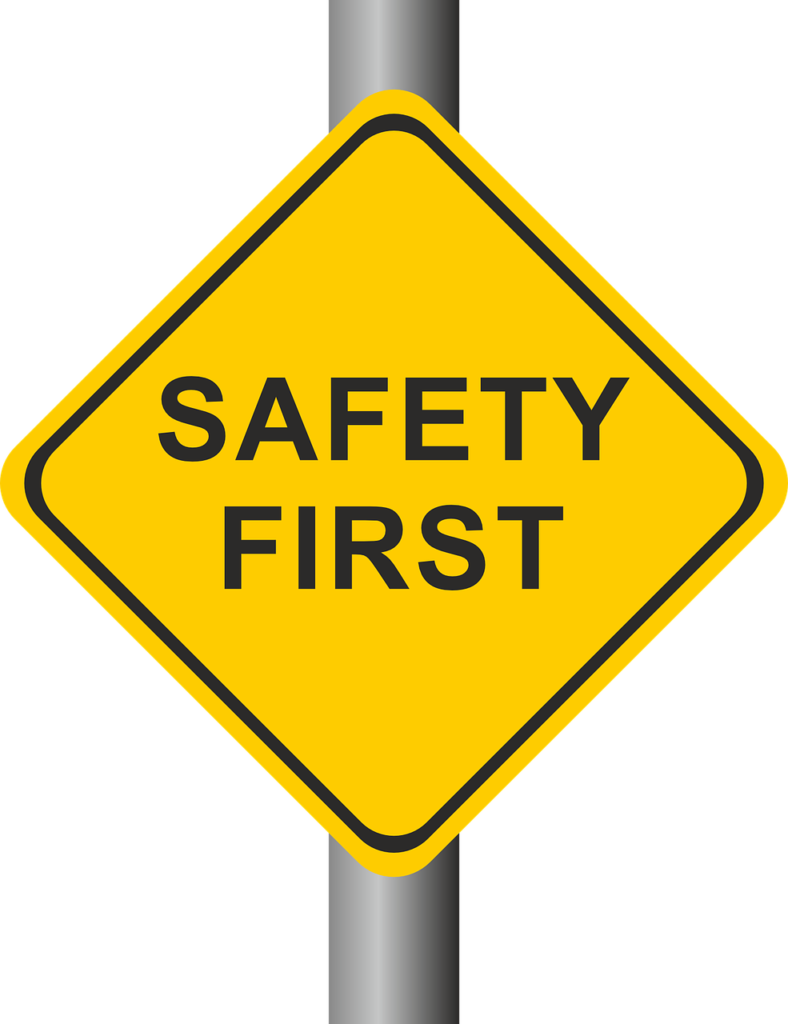
There has been a long-lasting belief that long-term creatine supplementation is not safe for humans. Later in this blog post (in section 21: “Are there side effects of creatine supplementation?”) we will dive into more specific common beliefs about the (un)safety of creatine supplementation. However, many studies have investigated the safety of creatine and found it so be safe and well tolerated (when used appropriately) in healthy humans, even with long-term supplementation of up to 30 grams per day for 5 years (12)!
So, in short: there is nothing to worry about with creatine supplementation for healthy humans.
Still there are many anecdotally reported side effects (such as nausea, diarrhea, gastrointestinal distress, muscle cramps, heat intolerance) with creatine supplementation. However, they have never been proven to be significant or different compared to merely a placebo. Also, isolated cases of adverse events have been attributed to already existing problems in the body such as preexisting organ failure, excessive dosing, or concurrent use of other harmful substances.
There is only one side effect that may be relevant for some athletes/people. This is the associated water retention and weight gain that often occurs with creatine supplementation. This side effect may be detrimental for athletes that need to have a low body mass (such as endurance athletes), but could actually also be beneficial for athletes that want to ‘look’ bigger, such as bodybuilders.
To further emphasize on the safety aspect, creatine is not banned by the World Anti-Doping Agency, the International Olympic Committee (IOC), or the National Collegiate Athletic Association (NCAA).
Still, elite athletes need to consider carefully what supplements they buy/ingest and make sure there are no contaminants in the creatine supplements they buy.
But taking all of this together, it can be concluded that creatine on itself is safe!
Now we have seen that creatine is safe, let’s see what the benefits are of creatine supplementation for the human body.
5. What is the impact of creatine for muscle building?

Creatine supplementation has been shown to have various benefits for enhancing resistance exercise capacity and promoting long-term training adaptations. By increasing the availability of creatine and phosphocreatine in muscles, it provides a quick source of energy during workouts, which allows you to do more exercise sets and repetitions. This, in turn, can lead to greater gains in muscle strength and mass over time.
For this section we will just cover the direct effects of creatine on gains in muscle mass. The impact on strength (via increased energy and thereby improved workouts) will be discussed in the next section.
The primary mechanism by which creatine appears to enhance muscle hypertrophy is through water retention within muscle cells. Studies have shown that creatine supplementation can increase intracellular body water content by approximately 2 liters (3, 13). The water retention caused by creatine already directly contributes to a bigger muscle size. However, the cell swelling can also create an intracellular environment that supports muscle growth.
The fact that the muscle cells hold on to more water, can act as an anabolic stimulus by triggering increases in signaling pathways and protein kinases in the muscle cell. This could theoretically (indirectly) lead to a stimulation of muscle protein synthesis (14) (it is important to note, however, that creatine has never been shown to directly increase muscle protein synthesis (54, 55)). Additionally, creatine may upregulate the hormone insulin-like growth factor-I (IGF-1) and myogenic transcription factors, which stimulate satellite cell activity, differentiation, and proliferation. So, in other words, creatine can help our bodies make more of the IGF-1 hormone and transcription factors that can tell our muscle cell that it should grow. Also, by stimulating satellite cell activity, this could help our muscle cells to indirectly become bigger. All these processes can increase the capacity for muscle protein synthesis (14, 15) and, subsequently, muscle growth (Figure 3).
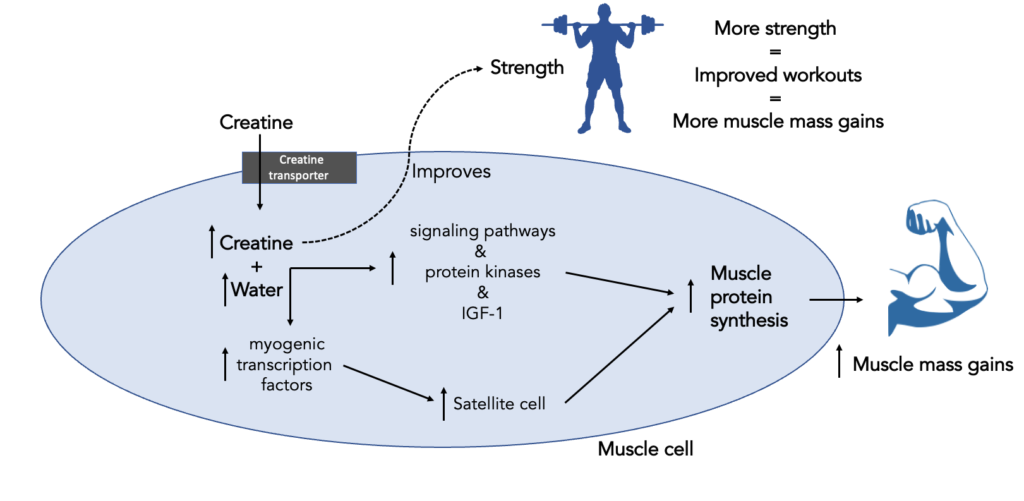
Figure 3. Potential effects of creatine supplementation in the skeletal muscle cells.
When ingesting creatine supplements, creatine can be taken up by our skeletal muscle cells via a creatine transporter. This will increase the creatine (both creatine and phosphocreatine) content in the muscle cells. Increased creatine in the muscle can also lead to extra water absorption into the muscle cells, which will expand the muscle cell (so it gets bigger). This can also lead to activation of several processes which contribute to increases in muscle growth. The increase in creatine and water in the muscle cell can lead to an anabolic stimulus via activation of signaling pathways, protein kinases, and IGF-1. It can also activate myogenic transcription factors which will activate, proliferate, and differentiate satellite cells. All these processes could potentially contribute to muscle growth via increasing muscle protein synthesis (however, keep in mind that there does not seem to be a direct effect of creatine on muscle protein synthesis). Creatine can also improve the quality of the training sessions (by extra energy provision) and thereby contribute to more muscle strength and more muscle mass gains in the longer-term.
Creatine also seems to exhibit the ability to inhibit the breakdown of muscle protein, reduce inflammation, and decrease oxidative stress, creating a more favorable environment for muscle growth over time (3).
Overall, there are multiple mechanisms by which creatine can lead to bigger muscles. But what about the research that actually measured the impact of creatine on lean body mass?
When looking into the gains you can make by supplementing with creatine, it has been shown that men, independent of their age, can gain on average 1.5 kg lean body mass. For women this is somewhat lower (~0.5 kg). This could be explained by the fact that women have higher resting intramuscular creatine stores compared with men, which may lower their responsiveness to creatine supplementation. Another explanation could be that women may not experience the same anticatabolic effects from creatine supplementation compared to men (3).
Although there appear to be differences, the good news is that both men and women can benefit from creatine supplementation.
It is also interesting that the majority of creatine in our muscles is found in our type II muscle fibers (16). The type II muscle fibers are the muscle fibers that are important for fast muscle contractions such as with weightlifting. Therefore, people with more or bigger type II muscle fibers may respond more favorably to creatine supplementation.
Overall, we can conclude that creatine is a smart decision for those that want to optimize gains in the gym. In fact, it’s even considered the most effective of all available legal supplements to increase lean body mass during periods of resistance exercise training.
As you have read, creatine can help you to optimize muscle building. But do you want to know how to really optimize your muscle building, subscribe then for our muscle building guide (here). In this guide you will learn everything about building muscle, first hand from scientist that are ‘the founders’ of all new knowledge in this topic.
6. What is the impact of creatine for muscle strength?

Given its provision of fast energy (ATP), creatine will improve the quality of training, and allow you to do more exercise sets and/or repetitions in the gym leading to greater gains in muscle strength. Depending on the increase in muscle phosphocreatine, this can lead to a 10-20% increase in gym performance (17). So, if you can normally perform 10 repetitions on the bench press with 100 kg (or 220 lbs), you can now perform 11 or 12 repetitions with the same weight. Not only does this make you stronger, but by being able to train better, you will benefit also with muscle gains in the long-term (see previous section).
Not only can increased phosphocreatine help to get more ATP during exercise, it may also lead to greater phosphocreatine recovery. This will improve the recovery between sets of resistance exercise. Creatine can also help with a better absorption of calcium within our muscle cells, which is an important mineral for muscle contraction. When our muscles increase the rate of calcium uptake within the cell (in an area called the sarcoplasmic reticulum), they can contract and relax faster, making them more powerful (18-20). Overall, this improves training volume. With increased training volume you can also improve your gains in muscle strength and this has been confirmed by previous studies (21).
Via these mechanisms creatine can improve muscle strength. However, how fast can this occur? And what gains in muscle strength can we actually expect from creatine?
There are studies that already reported beneficial effects on muscle strength within a relatively short time period of creatine supplementation (less than 2 weeks) (21), suggesting that the beneficial effects of creatine can already become clear very fast.
When focusing on actual strength gains that we can make, several studies combined have shown that creatine supplementation during a period of resistance exercise can lead to an average increase in muscle strength of ~8%. So, to put this into perspective, if your maximal bench press would increase to 120 kg with regular resistance training, it could increase to 130 kg if you would supplement with creatine.
Also, the average increase in muscular endurance (which is the number of repetitions completed at a specific weight) was ~14% greater when supplementing creatine during a period of resistance training.
When we put this into perspective, it means that we can improve from 15 repetitions at a 90 kg bench press to 17 repetitions at this weight.
More good news is that creatine has been shown to induce greater gains in several different exercises. For example, creatine has been shown to increase maximal strength in several powerlifting exercises such as the bench press and back squat (21).
It is also relevant to know that benefits are observed both in untrained but also already trained people. So, everyone can benefit from creatine.
Overall, creatine is considered the most effective (legal) supplement available to increase high-intensity exercise capacity during periods of resistance exercise training.
7. What is the impact of creatine for endurance exercise?

When looking at the effect of creatine in energy production, it is now clear that it is a supplement that provides quick energy. This means creatine is mostly beneficial during high-intensity explosive exercise bouts (such as with sprinting and resistance exercise).
With endurance exercise, athletes primarily use a different energy system (oxidative energy) that provides ATP at a more continuous and slower rate (22).
Taking this into account, it probably does not come as a surprise that creatine has not shown to be very beneficial for endurance exercise. Especially when the duration of exercise increases, the benefits of creatine are not that relevant anymore. Indeed, many studies have shown that supplementing with creatine has no effect on (sub)maximal oxygen consumption, time trial performance, or time-to-exhaustion (21, 23). So, in short creatine does not seem to be beneficial for direct performance improvements during long duration endurance exercise sessions.
Moreover, creatine supplementation may actually have some drawbacks for some endurance athletes, given the water retention and the associated weight gain that occurs after creatine supplementation. This can be problematic for many endurance athletes such as cyclists that need to climb the mountains as fast as possible (such as during the Tour de France).
However, creatine may still be of relevance for some aspects of endurance exercise.
Sprints:
It is interesting to note that during endurance events, cyclists often have to perform short high-intensity efforts such as repeated sprints. This could occur at the end of a race to determine who will win, but also more frequently during the race to (try to) escape from another group of cyclists.
In this respect it does not come as a surprise that creatine could benefit as it can increase maximal power output for cyclists. These benefits in sprint performance have already been shown after acute (5-6 days) as well as longer-term (4-6 weeks) of supplementation (21, 23).
So, during endurance events where athletes have to stay with the pack during breakaways or sprint to the finish, ingesting creatine can be beneficial (which can even be beneficial despite the increase in body mass) (24). Overall, there is promising data for creatine to enhance time-to-exhaustion endurance performance during short high-intensity duration exercise efforts such as sprints (25).
Endurance exercise in the heat:
Endurance athletes often have to perform under hot and humid conditions. This compromises thermoregulation and subsequent performance. Given that creatine is able to “hyper-hydrate” the muscle cells, it can enhance the body’s tolerance to heat (26, 27). Although the benefits of this do not seem to be very clear yet, this may potentially help athletes to reduce the risks of heat-related body problems (21).
Glycogen:
Creatine may also indirectly benefit endurance exercise performance via enhancing glycogen storage in the body. Glycogen is the storage of the carbohydrate glucose in our body. If we have more of this storage available, it will benefit us to provide energy during more prolonged exercises such as endurance exercise. Purely for the provision of energy, this storage can provide faster energy compared to fat, but slower compared to creatine. Especially for longer-term endurance exercises, this is the preferred energy source we can use and it will not come as a surprise that these stores are substantially reduced after a serious bout of endurance exercise. When looking at the impact of creatine, studies have shown that ingesting creatine can augment this glycogen storage in the muscle cells (11, 28). So, this will help us to have this energy quickly available again for the next endurance exercise session.
8. What is the impact of creatine for intermittent sports such as football, basketball, or martial arts?

Given that creatine helps our muscles to produce energy faster, it may also be a beneficial supplement for intermittent sports such as football, basketball or martial arts where frequent explosive events (such as kicks and sprints) take place. Let’s take a look at some important aspects of intermittent sports and what the evidence shows on whether creatine can be of benefit.
Agility:
Agility means the ability to move quickly, change direction easily and to react fast. It’s like being flexible, both physically and mentally. So, think here about a person that is able to quickly dodge obstacles or hits, adapts to new situations, or can make quick decisions without hesitation.
So far, when assessing all available evidence, the impact of creatine on agility remains unclear. Some studies show some benefits, whereas others do not find a benefit of creatine supplementation. Therefore, it seems that creatine has only limited potential to enhance agility performance (21).
Sprint performance:
We already sort of discussed the benefits of sprints with endurance exercise, but there are also studies looking into the effects of creatine supplementation for sprint performance in intermittent sports such as handball, football, ice hockey, soccer, swimming, and track athletics.
Overall, some studies have shown that athletes who took creatine supplements indeed experienced improvements in their sprinting abilities. For example, college football players who took a combination of creatine and carbohydrates saw better sprint performance. Similarly, well-trained male sprinters showed faster sprint times after taking creatine for five days. However, not all studies have consistently shown that creatine supplementation enhances sprint performance. Some research found no significant changes in sprinting abilities among active college-aged men or elite college sprinters after supplementing with creatine (21). Some reasons by which there are conflicting results, could be because of the increased body mass that occurs when supplementing creatine, that could offset some performance benefits in those athletes. Therefore, some, but not all, studies show benefits of creatine supplementation for sprint performance and this may depend on other factors (such as weight gain) that could counteract with some benefits.
Jump performance:
Jumping, both horizontally and vertically, is an important component for many athletes. Athletes need to generate a lot of power, relative to their body mass, to be able to jump. Therefore, the question is whether creatine can be of benefit here. On the one hand it provides quick energy, but on the other hand it increases body mass (which obviously makes it harder to jump higher).
As always in science, not all studies show the same effects. Many studies have shown (some) benefits of creatine on jump performance. However, not all studies showed significant results (21). Therefore, the impact of creatine on jumping performance seems to vary.
Overall, creatine could be beneficial for intermittent sports. However, scientific studies show variable results. Therefore, our advice is to look at the whole picture: what is the benefit and what is the drawback. So, think about the benefit of having extra ‘fast’ energy available in the muscle and weigh that against the added body mass that will occur with creatine supplementation.
9. What is the impact of creatine for bone strength?

There is only limited information on the impact of creatine for bone health. However, there is a potential of creatine to make our bones stronger. The mechanism is similar as in muscle, as it can also provide energy (ATP) for the bone cells (29).
When we look at our bones, they are continuously remodeling themselves. This means that the bone is constantly breaking its cells down and building them up again (to make sure that the bone cells remain ‘healthy’ and ‘functional’). There are two main cell types involved in this buildup and breakdown process. The osteoblasts buildup new bones and the osteoclasts breakdown the bones.
There are studies to indicate that creatine may improve the function of the osteoblasts (buildup cells) and possibly also reduce the activity of the osteoclasts (breakdown cells) (29). However, despite the potential, there are mixed findings in the literature on the impact of creatine for bone strength (16).
A long-term study supplementing creatine for 2 years in combination with resistance exercise training did not observe any effect on bone mineral density (30), which is a measure of bone strength.
To put it simply, we still don’t fully understand if and/or how creatine affects the bones, with some studies showing some benefits but other showing absolutely no benefits.
Therefore, so far there is not a good argument to make that creatine should be used to improve our bone strength and more research is necessary to further elucidate the impact of creatine on our bones.
10. What is the impact of creatine for recovery from exercise?

There is some research that suggests that creatine can also be beneficial during recovery from exercise (21). In this regard, scientist have mostly investigated the impact on markers of muscle damage, soreness, inflammation, and muscle function. However, there is much more to recovery than just those factors. Therefore, more work is needed to explore if creatine indeed is beneficial for recovery and, so far, exercise recovery should in our opinion not be the primary target for which you should use creatine.
11. What is the impact of creatine during injury or recovery from injury?

A few research studies have focused on the impact of creatine supplementation for injury and recovery from injury. Given that research in injury is difficult to perform, many research studies look at scientific models where participants are immobilized with a cast (such as what would happen when people would have a severe leg injury).
In these projects muscle mass and strength are being measured as well as the speed of recovery after injury. It could be of relevance to assess the impact of creatine supplementation for several reasons. One reason is because it appears that phosphocreatine in the muscle cells is lower when being immobilized. Also, the transporter necessary to transport creatine into the muscle cells is in fact higher in a leg that was immobilized (31), so there is potential to get more creatine into the cells. Therefore, there may be a benefit of increasing creatine in the muscle when being immobilized (such as with injury).
It is also possible that via increased water retention (and thus bigger muscle cells) the muscle cell can increase growth factors to make sure that the muscle becomes more anabolic (see also section 5: “What is the impact of creatine for muscle building?”).
Despite the promising theory by which creatine could be of benefit, the research investigating the effects of creatine supplementation during a period of immobilization did not find that creatine supplementation prevents muscle mass or strength loss (32, 33). Therefore, there does not seem to be much benefit of creatine supplementation when you are actually injured.
But what about when you are recovering from injury?
When supplementing creatine during recovery it may provide additional fast energy to improve your (rehabilitative) training sessions. In addition, muscle cell swelling and its accompanying anabolic muscle effects may also be beneficial during the recovery phase. Therefore, there are reasons to believe that creatine may be beneficial during this period to speed up recovery from injury.
Indeed, here there is in fact some evidence pointing towards a beneficial effect of creatine in speeding up the recovery process from injury (33). Therefore, with the limited available evidence, it appears that creatine supplementation, when combined with rehabilitation exercise, is a beneficial strategy to speed up recovery from injury.
Although most research has focused on the impact of creatine on our muscles, there is now also emerging evidence that creatine may be of benefit for our brains. So, let’s have a look into creatine and the brains.
12. BRAIN
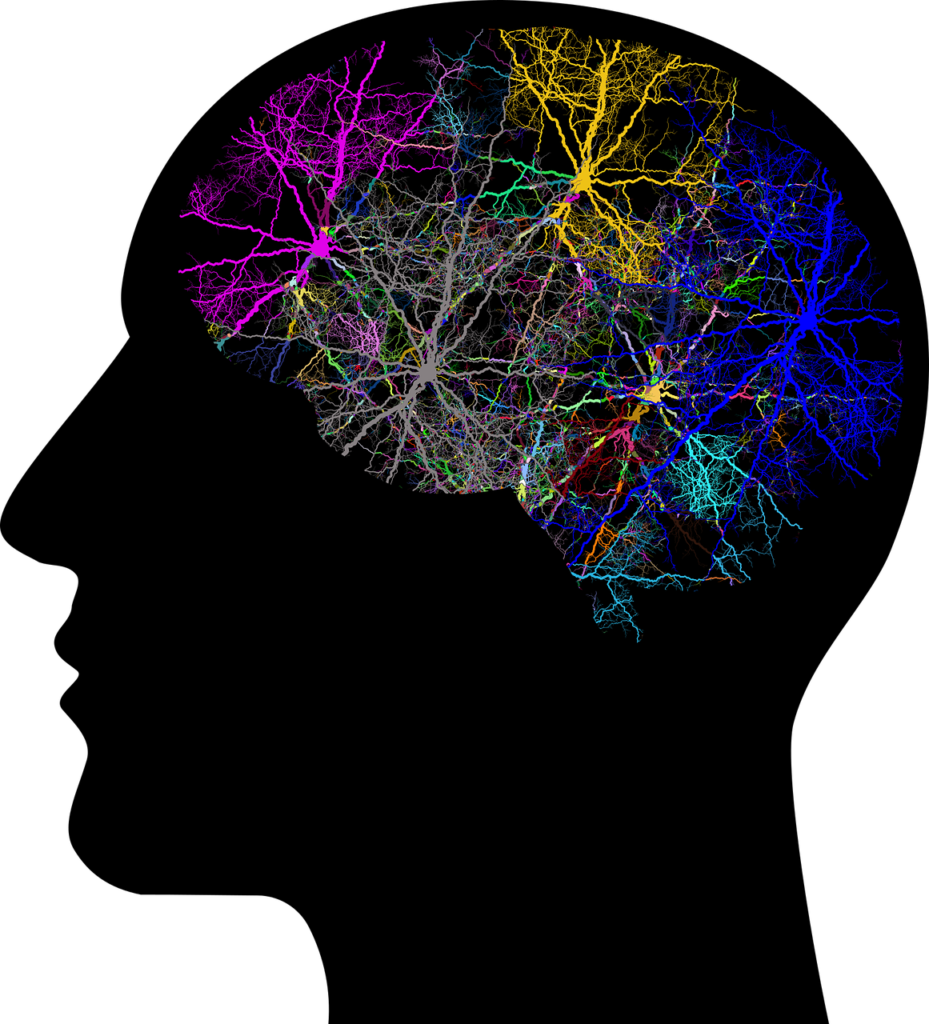
There is more and more research being performed these days on the impact of creatine on the brain. Despite that the brain is only ~2% of our total body mass, it consumes about 20% of our total body energy during the day. This highlights the importance of energy in our brain. This energy is required for our cognitive function, which encompasses our mental processes such as attention, concentration, memory, and problem-solving.
Maintaining a large supply of energy (ATP) can be challenging for our brains, especially during periods of increased cognitive demand, such as during tasks where we need to mentally focus for a long period of time. Therefore, given that creatine can provide ATP resynthesis in the brain (just like it does in the muscles), it can ensure a continuous supply of energy to the brain cells to fulfill their demanding (cognitive) tasks.
The brain has very little creatine (compared to the muscle), and it seems to produce creatine only in small amounts. However, the brain does contain receptors that allow creatine to enter into the brain (34). So, despite the low amount of creatine available, there is potential for creatine to be increased and to help with energy provision within our brain cells.
Given the potential, let’s have a closer look whether creatine can be a beneficial supplement for our brains.
13. Creatine supplementation for the brain:
Previous research has shown that brain creatine concentrations can be increased up to about 10% (which is lower compared to the increases we have seen in the muscles; 20-40%) (35). However, it is important to realize that the current dosing protocols are often based on our knowledge coming from raising creatine levels in the muscles. Therefore, future research may help us to understand if we can further increase the creatine levels with a different dosing protocol targeted for optimized creatine in the brain. Nonetheless, the most important aspect for now is that studies do show that creatine content increases in the brain during a period of creatine supplementation. But does this lead to benefits?
14. The impact of creatine on cognition:
There is promise for creatine supplementation to improve cognitive function. Recent work has looked at several research studies focusing on the impact of creatine supplementation for cognition. Some studies have found beneficial effects, whereas others have not shown any effect of creatine supplementation (36). It seems that the effects of creatine are more pronounced when cognition is already compromised, such as when one is sleep deprived. Also, perhaps a better dosing strategy will help us to get more insights into the (potential) benefits of creatine for cognition. Therefore, to completely understand the mechanisms and reach more firm conclusions on the link between creatine and cognitive performance, more investigation is required (37) and this will be an exciting area of research in the future.
Overall, keep in mind that when you already supplement with creatine to improve your muscle performance, it is interesting to realize that it can also be of benefit from a cognition point of view, especially during periods of sleep deprivation. So, this may already be an additional reason to consider using creatine.
15. The impact of creatine on mental health:

A substantial amount of people will have mental health illnesses at some point in their lives. It is believed that between 26 and 30 percent of Americans have a mental health condition every year (38). According to data from 2012, ~10% of people over the age of 15 in Canada were believed to have a mental health issue (39). Depression and generalized anxiety disorder are the two most prevalent conditions.
Research has shown that many of these mental health issues, such as low mood and depression, are linked with a low amount of creatine in the brain (40). This is interesting, because this may suggest that raising creatine levels in the brain may also be a beneficial strategy to improve mental health.
Indeed, there is promise for creatine supplementation to improve mental health issues such as depression, low mood states, anxiety, and post-traumatic stress disorder (37). However, certainly more research is needed in this area and will come in the upcoming years.
16. The impact of creatine on concussion and traumatic brain injury:

Another area of research where creatine has been shown promising results is in the area of concussion and traumatic brain injury. Concussions can often occur with contact sports, such as with American Football or Rugby.
After a concussion or traumatic brain injury, creatine content decreases (41, 42), and thus also here it could be of relevance to increase creatine content via supplementation. From the limited research performed in this area, positive results have been observed, showing improvements in memory, thinking, behavior, and faster recovery. Also, in animals research has shown that creatine before and after brain injury may help to protect the brain. It could reduce damage to the brain and keep the energy levels normal (37). Therefore, this also shows a potential relevance of creatine supplementation and this is another exciting research area to follow in the years to come.
17. Concluding remarks for creatine and the brain:
As we are always looking for optimal cognitive function, it is crucial to consider the importance of energy availability in our brain cells. Though the brain’s normal creatine levels are relatively low (compared to muscle), it can be increased via supplementation with creatine. Increasing creatine content in the brain could be beneficial for cognitive functioning. This may especially be relevant during periods when creatine levels are even lower than normal (such as during sleep deprivation).
More research in this area is needed, but creatine holds a great promise as a potential strategy to support brain energy and enhancing cognition.
Now we have seen the (potential) benefits of creatine for our muscles and brains. But if we choose to buy creatine, there are many different options available. So, what is the best form of creatine to buy?
18. What form of creatine is the best to buy?

The most extensively studied form of creatine is in the form of creatine monohydrate (7). Other forms of creatine have also been put on the market and claims have been made that these are superior to creatine monohydrate. Examples of other forms of creatine that you can find on the market are: creatine citrate, creatine ethyl ester, magnesium-creatine chelate, creatine malate, creatine nitrate, creatine pyruvate. Claims have been made that these other forms have an increased solubility, bioavailability, and superior uptake mechanisms. However, there is a lack of evidence to support many of these claims (43-45). In fact, there is only strong evidence for creatine monohydrate in terms of bioavailability, efficacy, and safety (45).
Therefore, so far there is no reason to buy any of the other forms of creatine and it seems merely a waste of money (see overview of price differences below). Our advice is to stick with creatine monohydrate, until new evidence comes out on superior forms (of which we, so far, remain skeptical). Of course, we will inform you when there are better options available.
Overview from: (44)
Per 5 g serving
Creatine Monohydrate $0.19
Creatine decanate $0.30
Creatine hydrochloride $0.42
Magnesium-creatine chelate $0.45
Creatine ethyl ester $0.53
Creatine gluconate $0.65
Creatine anhydrous $0.72
Buffered creatine $1.51
In conclusion, the most cost-effective form of creatine is creatine monohydrate.
19. What is the best creatine dosing or creatine intake strategy?
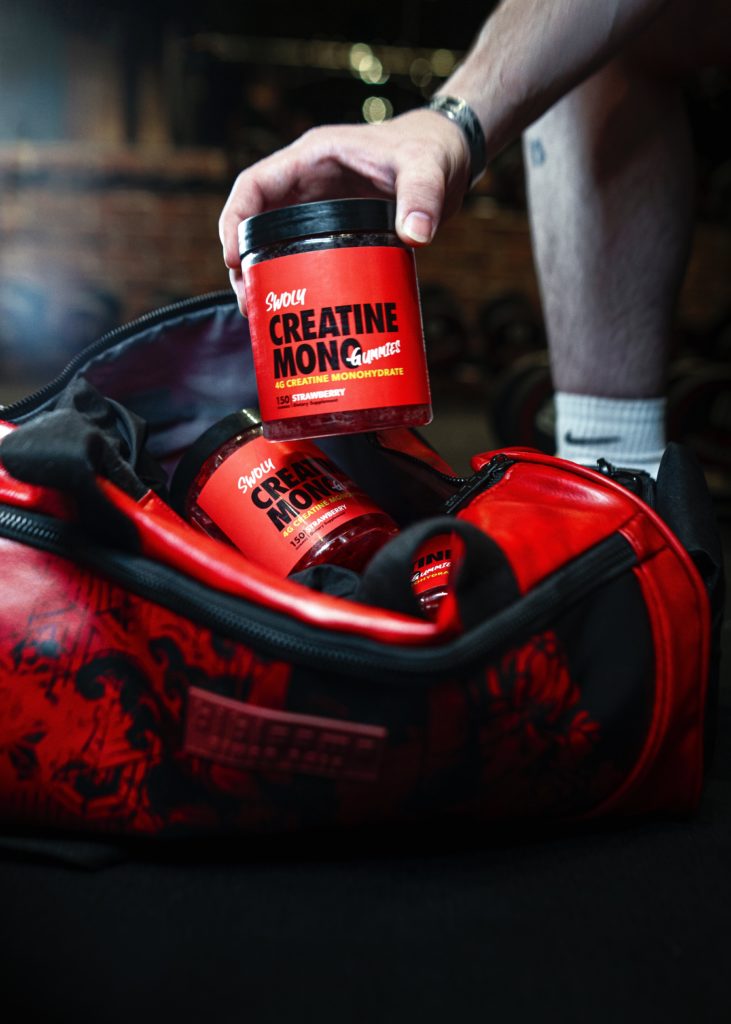
The most effective standard dosing strategy utilizes a loading phase of 20 g divided into four equal doses for 5 to 7 days. You can also calculate the amount based on your body mass. In this case, use ~0.3 gram per kilogram body mass per day. So, if you are a 75 kg individual, take about 22.5 grams per day for the first 5 to 7 days.
After the first 5 to 7 days, make sure you use a longer maintenance period where you ingest around 3 to 5 grams per day or maybe even up to 10 grams for larger athletes (or simply 0.1 gram per kilogram body mass per day) (7). As mentioned before, when you apply this strategy, you can increase your muscle creatine stores by about 20 – 40%.
Keep in mind that a loading phase is not absolutely necessary to increase the creatine stores in the muscle. However, if you don’t do this the amount of creatine will simply increase more slowly and it takes longer to maximize the creatine levels in your muscles (46).
Also, again keep in mind that this dosing protocol is targeted to optimize muscle creatine levels, it’s possible that a different dosing protocol for longer periods of time may be needed to further increase brain creatine concentrations, but we don’t know this yet and future work needs to investigate this further.
It is also important to highlight that it does not seem to matter (with currently available evidence) what time of the day you take creatine and there is no evidence to suggest that timing really matters (47). However, it is a good strategy to co-ingest creatine together with carbohydrates and/or protein, as this will increase the amount of creatine within our muscles. This can be explained by the increase in insulin concentrations after carbohydrate and protein ingestion. The increase in insulin will further open up our muscle cells (7, 48). Whether co-ingestion of creatine with carbohydrate and/or protein will also translate into better performance is not clear so far.
Also, as a final note it is important to realize that everybody can benefit from creatine supplementation (even though some individuals will benefit more than others). A big question always is whether both males and females and also whether older people will benefit? So, even though it has already been covered a bit previously in this blog post, let’s answer that question firmer here.
20. Are there differences between males and females and between young and old for creatine supplementation?

There do seem to be some differences between the responsiveness of males and females to creatine supplementation. Females have more creatine in the muscles and, thus, may respond not as good to creatine supplementation compared to males (8, 49). Also, creatine may influence females differently during the menstrual cycle (50). More research is clearly needed to investigate the differences between males and females.
The good news is that, despite there may be differences, creatine has shown beneficial effects in both men and women (from all ages) (21).
So, we now know the benefits of creatine and also how we can best supplement with creatine. We have also already briefly covered that creatine is a safe supplement. But what about the often mentioned (negative) side effects of creatine, are those not true?
21. Are there side effects of creatine supplementation?
There are worries about specific side effects of creatine supplementation. However, many of those concerns are not based on the truth. Let’s look at some commonly reported side effects and if they are actually true or not.
There have been concerns that when people supplement with creatine, that they will stop their own natural production within the body.
22. Does taking creatine lower your body’s natural production, and do you need to stop taking it to return to normal levels?
There is no evidence to suggest that muscle creatine levels fall below baseline when you stop supplementing with it. Therefore, there is no need to worry that long-term creatine supplementation will lead to low creatine levels after you stop supplementing (51, 52) and no direct need to stop taking creatine after 3 months for example.
In case you decide to stop creatine supplementation for a while, it will take about 4-6 weeks before your muscle creatine levels are back to normal as they were before supplementing (so, not suppressed!) (7).
23. Does creatine lead to hair loss/baldness?
Changes in hormones such as dihydrotestosterone have been linked to hair loss/baldness. Given that there have been (early) suggestions that creatine supplementation increased dihydrotestosterone, this has led to the theory that creatine leads to hair loss/baldness.
As a result of this concern, several scientific studies have investigated the links between creatine and hormones such as free testosterone (which the body uses to form dihydrotestosterone).
Overall, based on these studies it can be concluded that there are no indications that creatine increases the levels of total testosterone, free testosterone, or dihydrotestosterone. Also, there is no evidence showing that creatine causes hair loss or baldness (53). So, there is no need to worry about hair loss when supplementing with creatine.
24. Does creatine lead to kidney damage and/or renal dysfunction?
Based on scientific experiments and controlled studies, there is no evidence to suggest that taking creatine supplements at recommended dosages causes kidney damage or dysfunction in healthy individuals (53).
So, again, creatine can be considered a safe supplement to use.

25. Conclusion:
In conclusion, creatine is a naturally occurring compound that plays a vital role in energy metabolism, primarily stored in muscles. Supplementation with creatine has demonstrated benefits for muscle building, strength, and high-intensity exercise performance. It may also hold potential for improving cognitive function, mental health, and recovery from brain injuries. Creatine monohydrate is the most researched and recommended form. Proper dosing protocols and timing can optimize its effectiveness. Overall, creatine is a safe and effective supplement for individuals aiming to enhance physical performance and cognitive function.
Call to action:
Help others too with valuable knowledge!
If you found this information relevant, be a catalyst for change by sharing it with those who could benefit. Spread the word!
Moreover, if there’s anything you feel is missing from this blog post or any lingering questions in your mind, don’t hesitate to reach out. We’re committed to providing prompt updates and addressing your inquiries. Stay informed through this and other blog posts on Strictly Science!
Scientific references:
-
Walker JB. Creatine: biosynthesis, regulation, and function. Adv Enzymol Relat Areas Mol Biol. 1979;50:177-242.
-
Wyss M, and Kaddurah-Daouk R. Creatine and creatinine metabolism. Physiol Rev. 2000;80(3):1107-213.
-
Delpino FM, Figueiredo LM, Forbes SC, Candow DG, and Santos HO. Influence of age, sex, and type of exercise on the efficacy of creatine supplementation on lean body mass: A systematic review and meta-analysis of randomized clinical trials. Nutrition. 2022;103-104:111791.
-
Jung S, Bae YS, Kim HJ, Jayasena DD, Lee JH, Park HB, et al. Carnosine, anserine, creatine, and inosine 5′-monophosphate contents in breast and thigh meats from 5 lines of Korean native chicken. Poult Sci. 2013;92(12):3275-82.
-
Balsom PD, Soderlund K, and Ekblom B. Creatine in humans with special reference to creatine supplementation. Sports Med. 1994;18(4):268-80.
-
Purchas RW, Busboom JR, and Wilkinson BH. Changes in the forms of iron and in concentrations of taurine, carnosine, coenzyme Q(10), and creatine in beef longissimus muscle with cooking and simulated stomach and duodenal digestion. Meat Sci. 2006;74(3):443-9.
-
Kreider RB, Kalman DS, Antonio J, Ziegenfuss TN, Wildman R, Collins R, et al. International Society of Sports Nutrition position stand: safety and efficacy of creatine supplementation in exercise, sport, and medicine. J Int Soc Sports Nutr. 2017;14:18.
-
Candow DG, Forbes SC, Chilibeck PD, Cornish SM, Antonio J, and Kreider RB. Variables Influencing the Effectiveness of Creatine Supplementation as a Therapeutic Intervention for Sarcopenia. Front Nutr. 2019;6:124.
-
Greenhaff PL, Bodin K, Soderlund K, and Hultman E. Effect of oral creatine supplementation on skeletal muscle phosphocreatine resynthesis. Am J Physiol. 1994;266(5 Pt 1):E725-30.
-
Harris RC, Soderlund K, and Hultman E. Elevation of creatine in resting and exercised muscle of normal subjects by creatine supplementation. Clin Sci (Lond). 1992;83(3):367-74.
-
van Loon LJ, Murphy R, Oosterlaar AM, Cameron-Smith D, Hargreaves M, Wagenmakers AJ, et al. Creatine supplementation increases glycogen storage but not GLUT-4 expression in human skeletal muscle. Clin Sci (Lond). 2004;106(1):99-106.
-
Hall M, Manetta E, and Tupper K. Creatine Supplementation: An Update. Curr Sports Med Rep. 2021;20(7):338-44.
-
Powers ME, Arnold BL, Weltman AL, Perrin DH, Mistry D, Kahler DM, et al. Creatine Supplementation Increases Total Body Water Without Altering Fluid Distribution. J Athl Train. 2003;38(1):44-50.
-
Farshidfar F, Pinder MA, and Myrie SB. Creatine Supplementation and Skeletal Muscle Metabolism for Building Muscle Mass- Review of the Potential Mechanisms of Action. Curr Protein Pept Sci. 2017;18(12):1273-87.
-
Olsen S, Aagaard P, Kadi F, Tufekovic G, Verney J, Olesen JL, et al. Creatine supplementation augments the increase in satellite cell and myonuclei number in human skeletal muscle induced by strength training. J Physiol. 2006;573(Pt 2):525-34.
-
Gualano B, Rawson ES, Candow DG, and Chilibeck PD. Creatine supplementation in the aging population: effects on skeletal muscle, bone and brain. Amino Acids. 2016;48(8):1793-805.
-
Kreider RB. Effects of creatine supplementation on performance and training adaptations. Mol Cell Biochem. 2003;244(1-2):89-94.
-
Cooper R, Naclerio F, Allgrove J, and Jimenez A. Creatine supplementation with specific view to exercise/sports performance: an update. J Int Soc Sports Nutr. 2012;9(1):33.
-
Hespel P, Op’t Eijnde B, and Van Leemputte M. Opposite actions of caffeine and creatine on muscle relaxation time in humans. J Appl Physiol (1985). 2002;92(2):513-8.
-
van Leemputte M, Vandenberghe K, and Hespel P. Shortening of muscle relaxation time after creatine loading. J Appl Physiol (1985). 1999;86(3):840-4.
-
Wax B, Kerksick CM, Jagim AR, Mayo JJ, Lyons BC, and Kreider RB. Creatine for Exercise and Sports Performance, with Recovery Considerations for Healthy Populations. Nutrients. 2021;13(6).
-
Hawley JA, Hargreaves M, Joyner MJ, and Zierath JR. Integrative biology of exercise. Cell. 2014;159(4):738-49.
-
van Loon LJ, Oosterlaar AM, Hartgens F, Hesselink MK, Snow RJ, and Wagenmakers AJ. Effects of creatine loading and prolonged creatine supplementation on body composition, fuel selection, sprint and endurance performance in humans. Clin Sci (Lond). 2003;104(2):153-62.
-
Tomcik KA, Camera DM, Bone JL, Ross ML, Jeacocke NA, Tachtsis B, et al. Effects of Creatine and Carbohydrate Loading on Cycling Time Trial Performance. Med Sci Sports Exerc. 2018;50(1):141-50.
-
Forbes SC, Candow DG, Neto JHF, Kennedy MD, Forbes JL, Machado M, et al. Creatine supplementation and endurance performance: surges and sprints to win the race. J Int Soc Sports Nutr. 2023;20(1):2204071.
-
Volek JS, Mazzetti SA, Farquhar WB, Barnes BR, Gomez AL, and Kraemer WJ. Physiological responses to short-term exercise in the heat after creatine loading. Med Sci Sports Exerc. 2001;33(7):1101-8.
-
Weiss BA, and Powers ME. Creatine supplementation does not impair the thermoregulatory response during a bout of exercise in the heat. J Sports Med Phys Fitness. 2006;46(4):555-63.
-
Roberts PA, Fox J, Peirce N, Jones SW, Casey A, and Greenhaff PL. Creatine ingestion augments dietary carbohydrate mediated muscle glycogen supercompensation during the initial 24 h of recovery following prolonged exhaustive exercise in humans. Amino Acids. 2016;48(8):1831-42.
-
Gerber I, ap Gwynn I, Alini M, and Wallimann T. Stimulatory effects of creatine on metabolic activity, differentiation and mineralization of primary osteoblast-like cells in monolayer and micromass cell cultures. Eur Cell Mater. 2005;10:8-22.
-
Chilibeck PD, Candow DG, Gordon JJ, Duff WRD, Mason R, Shaw K, et al. A 2-Year Randomized Controlled Trial on Creatine Supplementation during Exercise for Postmenopausal Bone Health. Med Sci Sports Exerc. 2023.
-
Luo D, Edwards S, Smeuninx B, McKendry J, Nishimura Y, Perkins M, et al. Immobilization Leads to Alterations in Intracellular Phosphagen and Creatine Transporter Content in Human Skeletal Muscle. Am J Physiol Cell Physiol. 2020.
-
Backx EMP, Hangelbroek R, Snijders T, Verscheijden ML, Verdijk LB, de Groot L, et al. Creatine Loading Does Not Preserve Muscle Mass or Strength During Leg Immobilization in Healthy, Young Males: A Randomized Controlled Trial. Sports Med. 2017;47(8):1661-71.
-
Hespel P, Op’t Eijnde B, Van Leemputte M, Urso B, Greenhaff PL, Labarque V, et al. Oral creatine supplementation facilitates the rehabilitation of disuse atrophy and alters the expression of muscle myogenic factors in humans. J Physiol. 2001;536(Pt 2):625-33.
-
Fernandes-Pires G, and Braissant O. Current and potential new treatment strategies for creatine deficiency syndromes. Mol Genet Metab. 2022;135(1):15-26.
-
Dolan E, Gualano B, and Rawson ES. Beyond muscle: the effects of creatine supplementation on brain creatine, cognitive processing, and traumatic brain injury. Eur J Sport Sci. 2019;19(1):1-14.
-
Roschel H, Gualano B, Ostojic SM, and Rawson ES. Creatine Supplementation and Brain Health. Nutrients. 2021;13(2).
-
Forbes SC, Cordingley DM, Cornish SM, Gualano B, Roschel H, Ostojic SM, et al. Effects of Creatine Supplementation on Brain Function and Health. Nutrients. 2022;14(5).
-
Kessler RC, Chiu WT, Demler O, Merikangas KR, and Walters EE. Prevalence, severity, and comorbidity of 12-month DSM-IV disorders in the National Comorbidity Survey Replication. Arch Gen Psychiatry. 2005;62(6):617-27.
-
Palay J, Taillieu TL, Afifi TO, Turner S, Bolton JM, Enns MW, et al. Prevalence of Mental Disorders and Suicidality in Canadian Provinces. Can J Psychiatry. 2019;64(11):761-9.
-
Faulkner P, Paioni SL, Kozhuharova P, Orlov N, Lythgoe DJ, Daniju Y, et al. Relationship between depression, prefrontal creatine and grey matter volume. J Psychopharmacol. 2021;35(12):1464-72.
-
Signoretti S, Di Pietro V, Vagnozzi R, Lazzarino G, Amorini AM, Belli A, et al. Transient alterations of creatine, creatine phosphate, N-acetylaspartate and high-energy phosphates after mild traumatic brain injury in the rat. Mol Cell Biochem. 2010;333(1-2):269-77.
-
Vagnozzi R, Signoretti S, Floris R, Marziali S, Manara M, Amorini AM, et al. Decrease in N-acetylaspartate following concussion may be coupled to decrease in creatine. J Head Trauma Rehabil. 2013;28(4):284-92.
-
Jager R, Purpura M, Shao A, Inoue T, and Kreider RB. Analysis of the efficacy, safety, and regulatory status of novel forms of creatine. Amino Acids. 2011;40(5):1369-83.
-
Fazio C, Elder CL, and Harris MM. Efficacy of Alternative Forms of Creatine Supplementation on Improving Performance and Body Composition in Healthy Subjects: A Systematic Review. J Strength Cond Res. 2022;36(9):2663-70.
-
Kreider RB, Jager R, and Purpura M. Bioavailability, Efficacy, Safety, and Regulatory Status of Creatine and Related Compounds: A Critical Review. Nutrients. 2022;14(5).
-
Hultman E, Soderlund K, Timmons JA, Cederblad G, and Greenhaff PL. Muscle creatine loading in men. J Appl Physiol (1985). 1996;81(1):232-7.
-
Candow DG, Forbes SC, Roberts MD, Roy BD, Antonio J, Smith-Ryan AE, et al. Creatine O’Clock: Does Timing of Ingestion Really Influence Muscle Mass and Performance? Front Sports Act Living. 2022;4:893714.
-
Maughan RJ, Burke LM, Dvorak J, Larson-Meyer DE, Peeling P, Phillips SM, et al. IOC Consensus Statement: Dietary Supplements and the High-Performance Athlete. Int J Sport Nutr Exerc Metab. 2018;28(2):104-25.
-
Forbes SC, Sletten N, Durrer C, Myette-Cote E, Candow D, and Little JP. Creatine Monohydrate Supplementation Does Not Augment Fitness, Performance, or Body Composition Adaptations in Response to Four Weeks of High-Intensity Interval Training in Young Females. Int J Sport Nutr Exerc Metab. 2017;27(3):285-92.
-
Moore SR, Gordon AN, Cabre HE, Hackney AC, and Smith-Ryan AE. A Randomized Controlled Trial of Changes in Fluid Distribution across Menstrual Phases with Creatine Supplementation. Nutrients. 2023;15(2).
-
Kim HJ, Kim CK, Carpentier A, and Poortmans JR. Studies on the safety of creatine supplementation. Amino Acids. 2011;40(5):1409-18.
-
Kreider RB, Melton C, Rasmussen CJ, Greenwood M, Lancaster S, Cantler EC, et al. Long-term creatine supplementation does not significantly affect clinical markers of health in athletes. Mol Cell Biochem. 2003;244(1-2):95-104.
-
Antonio J, Candow DG, Forbes SC, Gualano B, Jagim AR, Kreider RB, et al. Common questions and misconceptions about creatine supplementation: what does the scientific evidence really show? J Int Soc Sports Nutr. 2021;18(1):13.
-
Louis M, Poortmans JR, Francaux M, Berre J, Boisseau N, Brassine E, et al. No effect of creatine supplementation on human myofibrillar and sarcoplasmic protein synthesis after resistance exercise. Am J Physiol Endocrinol Metab. 2003;285(5):E1089-94.
-
Louis M, Poortmans JR, Francaux M, Hultman E, Berre J, Boisseau N, et al. Creatine supplementation has no effect on human muscle protein turnover at rest in the postabsorptive or fed states. Am J Physiol Endocrinol Metab. 2003;284(4):E764-70.
🧬 The scientific guide to building muscle mass by Dr. Cas Fuchs (Ph.D.) is currently under development. Sign up to be the first to hear when it launches:
